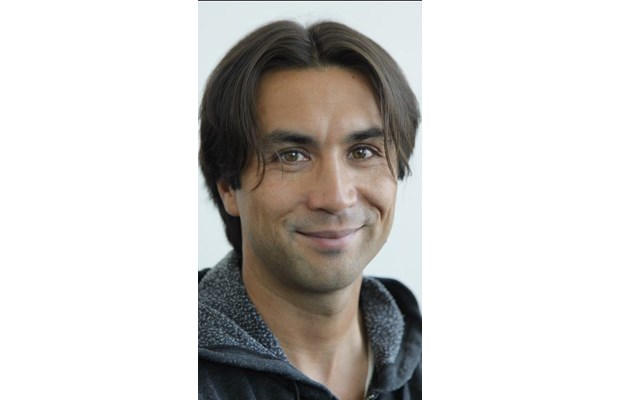Sean White has shared plenty on Facebook, but it doesn't compare to what he'll share in person this week.
"It's my way of trying to share some of the magic I've experienced," says White, explaining why he'll be at the Royal B.C.
Museum's IMAX Victoria Theatre on Friday for the world première of Terra Sacra, his short film featuring time-lapse sequences of exotic landscapes and monuments he has photographed around the world while travelling or on assignment.
His visually striking sixminute photographic journey, set to a mystical score by Roy Milner, showcases images that are at once beautiful and other-worldly, captured in locations in 24 countries including Australia, Cambodia, Japan, Nepal and Bhutan.
Living up to its title - Latin for "sacred earth" - White's digital tapestry evokes awe as time-lapse images of pyramids, an Arctic wildlife refuge, stellar desert landscapes and penguins chilling by snowcovered peaks on South Georgia Island flicker.
It prompts memories of Ron Fricke's non-verbal meditative masterpieces Koyaanisqatsi and Baraka.
"Baraka inspired me to get into travel and photography back in the day," recalled the Victoria-born filmmaker and photojournalist, who now lives in Tofino with his wife Deddeda White, an award-winning photographic artist herself.
"It was a style and esthetic I aspired to.
Through the years, I'd take a picture and say, 'This is a great Baraka shot,'" he continued. "Deddeda and my father pushed me to do something with them, so I compiled them into my own mini-Baraka."
It took six years for the former Times Colonist photographer, whose award-winning images have appeared in GQ, Outside, Sports Illustrated and other publications, to find enough time to assemble his favourites into a film.
He says he began experimenting with time-lapse photography in 2005, setting up his Canon 5D camera and a tripod to shoot images in remote locations during personal travels, or while off shooting high-definition video imagery on assignment as cinematographer on shows like Art Wolfe's Travels to the Edge and Ancient Megastructures for National Geographic Channel.
As technology advanced, he moved up to the Canon 7D and the Canon 5D mkll.
"The time-lapse thing is a bridge because each of those is a still image in a
way," he said. "It's a fusion now. I shoot more stills on my TV projects now than ever. I've used a lot for visual effects, and background plates we animate."
Producers can now do things with stills they couldn't do before because the tools and techniques weren't available, said White, whose other films include Snap, Unizaba and Beyond Gravity.
He said he's grateful to Wolfe, colleagues such as 3D gurus Ian Herring and Maija Leivo at White Rock's Parallax Film Productions and others for letting him use shots gathered in the line of duty in locations many can only dream of visiting.
He considers himself blessed having also been granted unprecedented access to some the world's most ancient landmarks, such as the castles he shot for Parallax's Battle Castle, the Discovery, History Television and BBC series.
His favourite experiences include two visits to Peru's Machu Picchu - "one of those amazing places that lives up to your expectations" - and sleeping under the stars in the middle of the Sahara after travelling from Timbuktu to shoot camel caravans.
"The stars were so bright and clear you could see the sand at nighttime," he recalled. "It was this surreal image- being able to see in the middle of the night. There was this supernatural energy I wasn't expecting to feel there."
He just wishes he had more time to come up for air long enough to truly appreciate the global wonders he was photographing.
"We were in Syria when the revolution broke out, in Mongolia when the riots took place," White recalled. "After you've been there, you say 'that was cool,' but at the time, it was a lot of hard work."
After venturing into the brave new world of stereoscopic 3D production with Parallax, White says he now thinks more about the 3D potential of future projects. He even wishes he could revisit the Terra Sacra locations to shoot them in 3D.
Although he's aware 3D has its detractors as the debate about its future rages on, he's convinced it will take off.
"Right now it's hard for everyone to access it. You have to buy an expensive TV, learn all this information, buy a Blu-Ray or watch a movie to access it," he said, noting that's all about to change with the emergence of autostereoscopy.
"It's basically 3D without the glasses. You'll see it on tablets, phones and computer monitors before you see it on TV."
Although Terra Sacra will be viewed on YouTube, iPads and smartphones when released online for free this Saturday, he couldn't resist sound designer Tim Archer's suggestion it first be digitally projected onto the IMAX screen in 5.1 Surround Sound.
You can see the results for yourself - for free - on Friday at 9 p.m.
On the web: terra-sacra.com
MARIGOLD BLOOMS: It seems Victoria filmgoers can't get enough of films from the old country with an exotic twist. Cineplex Odeon manager Pierre Gauthier and his staff fielded so many advance inquires about The Best Exotic Marigold Hotel they're adding 4 p.m. matinées this week for the benefit of an older demographic with a preference for seeing certain films downtown in that time slot.
The comedy that stars Judi Dench and Maggie Smith and relates the experiences of British seniors who decide to "outsource" their retirements to a hotel of dubious distinction in India is also playing at at the Star and Empire's University Cinemas.
If this week's Odeon matinee experiment is successful, Gauthier says they'll likely continue the limited matinee series.
mreid@timescolonist.com



